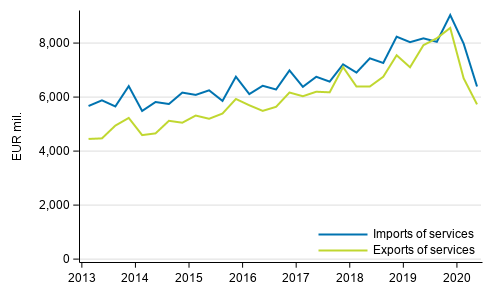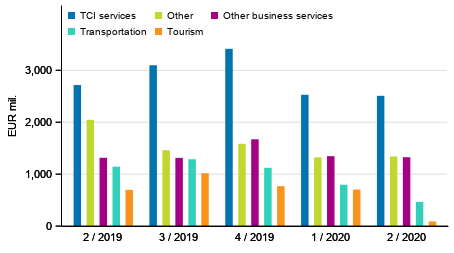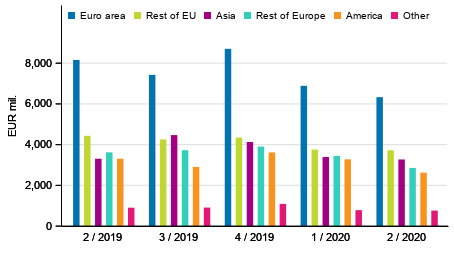Published: 18 September 2020
International trade contracted clearly in the second quarter of 2020
In the second quarter of 2020, the combined exports of goods and services decreased by 18 per cent relative to the corresponding quarter of the previous year. International trade, or exports and imports, fell in both goods and services. Twenty-eight per cent less services were exported and 22 per cent less services were imported than in the previous year. The relative decrease in international trade was smallest in goods exports, which went down by 12 per cent. Imports of goods, in turn, fell by 20 per cent. These data derive from Statistics Finland's statistics on international trade in goods and services, which are part of balance of payments .
Figure 1. Imports and exports of services quarterly (Corrected on 10 March 2021)

Exports of services and goods decreased in total by slightly over EUR four billion compared with the second quarter of the previous year. In the second quarter of 2019, goods amounting to EUR 15.8 billion and services amounting to EUR 7.9 billion were exported from Finland, but in the corresponding quarter of 2020, the value of goods exports was EUR 13.8 billion and that of service exports EUR 5.7 billion. Thus, exports of goods diminished by 12 per cent and exports of services by 28 per cent. In terms of service exports, especially exports of travel and transport services developed weakly and the value of these two items fell by a total of EUR 1.3 billion. The ratio of the contraction of exports of travel and transport to the fall in total service exports was thus as much as 59 per cent.
Exports of travel and transport services fell further
Travel to Finland and from Finland abroad has decreased clearly. Travel to Finland, which is recorded as travel exports, was 87 per cent lower in the second quarter of 2020 than one year earlier. Travel from Finland abroad, or imports of travel, fell by 93 per cent, in turn. In the second quarter of 2019, income from exports of travel amounted to EUR 0.7 billion, while the value of imports of travel was EUR 1.3 billion. In the second quarter of 2020, the value of both exports and imports of travel was slightly under EUR 0.1 billion. The fall in service exports during the first quarter of 2020 was also due to the weak development in travel and transport services, and the same trend continued even stronger in the past quarter.
International trade in transport services depends on the state of international trade in both travel and goods, which was not favourable. The value of exports of transport services was EUR 1.1 billion in the second quarter of 2019, but in the past quarter it had fallen to EUR 0.5 billion. Transport exports thus declined by 59 per cent. Imports of transport services also decreased clearly from the previous year.
Figure 2. Exports of services by service item

Service exports did not grow significantly in any item
In other service items, exports contracted most in charges for the use of intellectual property. Their total value in the second quarter of 2019 was EUR 1.1 billion and the fall from this level was around EUR 0.5 billion. Although the value of the item decreased by as much as 43 per cent, its level has not changed as much compared to the other quarters of 2019. A significant decrease was also recorded in the exports of telecommunications, computer and information services (ICT), which decreased by EUR 0.2 billion. However, exports of ICT continued to be the largest item in service exports valued at EUR 2.5 billion. In addition, the value of exports of manufacturing services decreased by EUR 0.2 billion from its level of EUR 0.5 billion one year ago, which corresponds to a contraction of around one third.
The year 2019 was a period of growth especially for exports of ICT services, but in the past quarter the exports of that and other service items did not grow relative to the year before, apart from exports of technical, trade-related and other business services. However, even in this service item the growth amounted to only EUR 45 million.
Imports of services also fell in the second quarter of 2020 and it is explained, as in exports, by the steep decline in travel and transport. However, imports of certain service items increased compared to the second quarter of 2019. Especially imports of ICT services grew by EUR 101 million or 10 per cent. In addition, charges for the use of intellectual property and imports of construction and manufacturing services increased slightly. By contrast, imports of other business services decreased by EUR 175 million, i.e. by more than the increase in other service items taken together. In particular, imports of research and development services belonging to this item decreased by EUR 133 million.
Exports to Europe decreased but the continent was still the biggest market area
The value of exports to Europe contracted by EUR 3.3 billion from the respective quarter of the year before. Because the value of total exports decreased by EUR 4.2 billion, the ratio of the drop in European exports to the drop in all exports was as high as 79 per cent. In the past quarter, goods and services for a total of EUR 12.9 billion were exported to Europe, while the corresponding figure last year was EUR 16.2 billion.
The fall in exports was great especially concerning Sweden and Germany. Exports to Sweden fell by EUR 0.4 billion from the level of EUR 3.0 billion one year ago and exports to Germany by EUR 0.5 billion from the level of EUR 2.1 billion. Exports to other European countries also decreased. The values of exports to both the United Kingdom and Russia were EUR 1.1 billion in the second quarter of 2019 and for both countries the drop in exports was of the same size, that is, EUR 0.3 billion.
Exports of services to Germany decreased by 41 per cent, or relatively more than exports of goods, which went down by 16 per cent. Measured in relative terms, service exports to Europe in general went down by 32 per cent from the quarter one year ago, or more than goods exports, where the corresponding contraction was 15 per cent. Here, too, there were country-specific differences, because concerning Sweden and the United Kingdom, for example, the relative decrease in exports of services and goods was similar.
Europe's share of Finland's exports was 66 per cent and it did not significantly decrease from the year before. Exports to America went down by EUR 0.7 billion, which is due to the contraction of exports to the United States by one third from one year ago. Most of this is caused by a drop in goods exports. Goods were exported to the United States to the tune of EUR 1.7 billion in the second quarter of 2019, while in the past quarter the level had fallen to EUR one billion. In turn, exports to Africa decreased less and exports to Asia did not change much from their EUR 3.3 billion level.
Among Asian countries, exports to China, however, grew by as much as 69 per cent from one year ago. On the other hand, the level of exports in the second quarter of 2020, that is, EUR 1.1 billion, was not higher than towards the end of 2019. Imports from China also grew by 12 per cent and were valued at EUR 1.6 billion in the past quarter. The growth in international trade with China was expressly caused by goods trade, because exports and imports of services decreased slightly. In general terms, service exports decreased clearly in Asia, for example, in Japan and South Korea.
As with exports, imports also decreased in Europe. The value of imports was EUR 19.0 billion one year ago, which fell to EUR 14.6 billion. Unlike the changes in exports, Russia had a bigger weight in the decrease in imports. Imports from Russia went down by as much as 52 per cent from the EUR 2.3 billion level in the previous year's quarter. In the past quarter, goods amounting to EUR 1.0 billion and services amounting to EUR 0.1 billion were imported from Russia, while one year ago the respective figures were EUR 2.0 billion and EUR 0.2 billion.
Figure 3. Exports of goods and services in balance of payments terms by area

Statistics on international trade
The statistics on international trade in goods and services are part of balance of payments . The statistics comprise breakdowns of goods and services on a more detailed level. The guidelines and recommendations of the Balance of Payments Manual (BPM6) applied to balance of payments are consistent with the European System of Accounts (ESA 2010). National Accounts are published on quarterly and annual levels . Finnish Customs publishes data on goods trade across borders. Goods trade published by Finnish Customs is used as source data for the statistics on international trade in goods and services. Removals and additions caused by definitions are made to them to achieve goods trade in balance of payments terms.
Finnish Customs’ statistical service, tilastot@tulli.fi, +358 29 552 335.
Source: International trade in goods and services 2018, Statistics Finland
Inquiries: Kasperi Lavikainen 029 551 3674, Risto Sippola 029 551 3383, globalisaatio.tilastot@stat.fi
Head of Department in charge: Mari Ylä-Jarkko
Publication in pdf-format (278.7 kB)
- Tables
-
Tables in databases
Pick the data you need into tables, view the data as graphs, or download the data for your use.
Appendix tables
- Revisions in these statistics
-
- Revisions in these statistics (18.9.2020)
Updated 18.9.2020
Official Statistics of Finland (OSF):
International trade in goods and services [e-publication].
ISSN=2343-4244. 2nd quarter 2020. Helsinki: Statistics Finland [referred: 20.4.2025].
Access method: http://stat.fi/til/tpulk/2020/02/tpulk_2020_02_2020-09-18_tie_001_en.html

